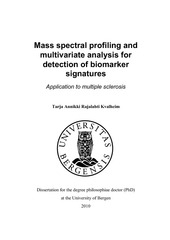Mass spectral profiling and multivariate analysis for detection of biomarker signatures. Application to multiple sclerosis
Doctoral thesis
Permanent lenke
https://hdl.handle.net/1956/4451Utgivelsesdato
2010-10-28Metadata
Vis full innførselSamlinger
Sammendrag
Mass spectrometry based protein profiling and biomarker discovery has given rise to the field of clinical proteomics. The underlying assumption is that proteins can provide information of diagnostic or therapeutic value and can thus be used in a clinical context. This thesis presents a novel approach where full mass spectral profiling and multivariate data analysis are combined to reveal biomarker signatures from complex body fluid samples. Matrix-assisted laser desorption/ionization time-offlight (MALDI-TOF) mass spectrometry is employed for acquiring full spectral profiles of intact proteins in cerebrospinal fluid (CSF) proteome. Since MALDI-TOF is relatively straightforward to use and demands relatively simple analytical work-up, it may have the potential to be used on routine basis in clinical laboratories. Multiple sclerosis (MS) is used as a model disease to demonstrate how this approach works on real proteomics data. The aim is to detect a disease signature typical for MS and use it in disease classification. MS is an example of a disease that may be difficult to diagnose at its very early stage and there is a need for diagnostic biomarkers for early diagnosis and treatment. It should however be mentioned that the developed approach is general and can be applied for other diseases, body fluids and instrumental techniques as well. This thesis is composed of four scientific papers, each one focusing on a specific problem. In the first study (Paper I) different methods for pretreatment of spectral profiles are tested. The aim of this study is to obtain recipes for elimination of noncompositional factors and thus improve reproducibility and minimize within-group variation compared to between-group variation. Statistical experimental design is used to assess the effect of each pretreatment step and examine if there are significant interactions between these steps. An optimal pretreatment strategy is developed and applied to further work. In the second and third study (Papers II and III) new chemometric methods are developed for detection of biomarker signatures in complex spectral profiles. In Paper II a so-called selectivity ratio (SR) and accompanying SR plot are presented for the first time and validated using spiked CSF samples. In Paper III a non-parametric discriminating variable (DIVA) test is introduced. DIVA test can be used in combination with SR plot to define statistical boundaries for biomarker detection. Both methods are in fact general and can be applied for most kind of variable selection problems. In the fourth study (Paper IV) the novel multivariate approach (including data pretreatment, SR and DIVA) is applied to real proteomic data derived from CSF samples from three different patient groups (MS, other neurological diseases and neurological healthy controls). The presented approach is able to discriminate the groups and the most important mass spectral regions (i.e. m/z values) contributing to separation can be found. These m/z values can be seen as a biomarker signature that can be used in disease classification.
Består av
Paper I: Analytical Chemistry 79(18), Arneberg, R.; Rajalahti, T.; Flikka, K.; Berven, F. S.; Kroksveen, A. C.; Berle, M.; Myhr, K.-M.; Vedeler, C. A.; Ulvik, R. J.; Kvalheim, O. M., Pretreatment of mass spectral profiles: Application to proteomic data, pp. 7014-7026. Copyright 2007 American Chemical Society. Full text not available in BORA due to publisher restrictions. The published version is available at: http://dx.doi.org/10.1021/ac070946sPaper II: Chemometrics and Intelligent Laboratory Systems 95(1), Rajalahti, T.; Arneberg, R.; Berven, F. S.; Myhr, K.-M.; Ulvik, R. J.; Kvalheim, O. M., Biomarker discovery in mass spectral profiles by means of selectivity ratio plot, pp. 35-48. Copyright 2008 Elsevier. Full text not available in BORA due to publisher restrictions. The published version is available at: http://dx.doi.org/10.1016/j.chemolab.2008.08.004
Paper III: Analytical Chemistry 81(7), Rajalahti, T.; Arneberg, R.; Kroksveen, A. C.; Berle, M.; Myhr, K.-M.; Kvalheim, O. M., Discriminating variable test and selectivity ratio plot: Quantitative tools for interpretation and variable (biomarker) selection in complex spectral or chromatographic profiles, pp. 2581-2590. Copyright 2009 American Chemical Society. Full text not available in BORA due to publisher restrictions. The published version is available at: http://dx.doi.org/10.1021/ac802514y
Paper IV: Journal of Proteome Research 9(7), Rajalahti, T.; Kroksveen, A. C.; Arneberg, R.; Berven, F. S.; Vedeler, C. A.; Myhr, K.-M..; Kvalheim, O. M., A multivariate approach to reveal biomarker signatures for disease classification: Application to mass spectral profiles of cerebrospinal fluid from patients with multiple sclerosis, pp. 3608-3620. Copyright 2010 American Chemical Society. Full text not available in BORA due to publisher restrictions. The published version is available at: http://dx.doi.org/10.1021/pr100142m
Utgiver
The University of BergenOpphavsrett
Copyright the author. All rights reservedThe author
